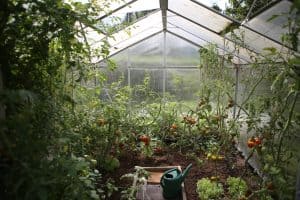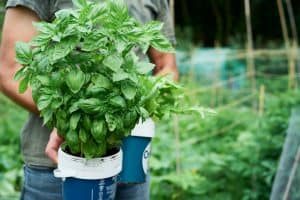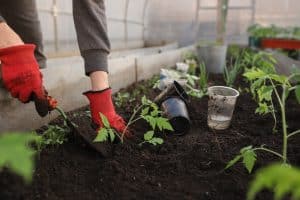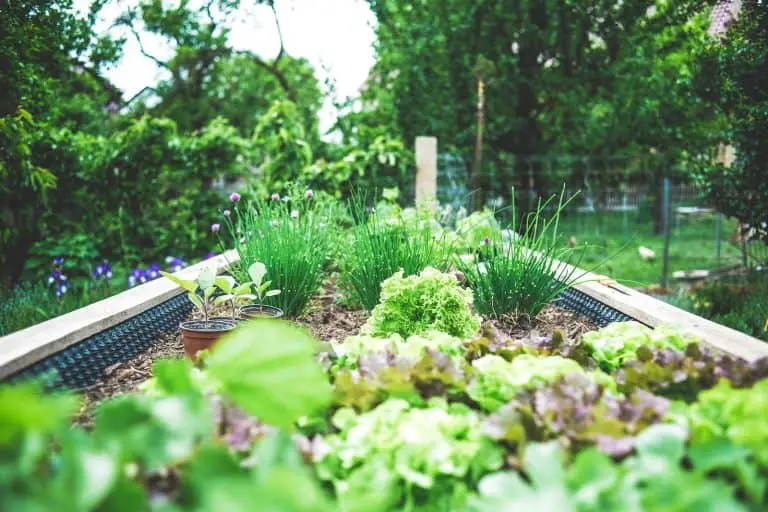Are you looking to create a thriving herb garden that not only saves space but also enhances the growth of your favorite herbs? Companion planting might be the secret ingredient you’ve been missing in your gardening journey.
In this comprehensive guide, we’ll explore the world of “Herbal Harmony” and discover which herbs that can be planted together to achieve a bountiful harvest, repel pests, and attract beneficial insects. So, roll up your sleeves, grab your gardening tools, and let’s dive into the aromatic and flavorful realm of companion planting with herbs.
Understanding the Magic of Companion Planting

A Tradition Rooted in History
Companion planting is a tradition that dates back centuries. It draws from the wisdom of gardeners and farmers who observed the interactions between different plant species and noticed that certain combinations led to improved growth and protection against pests and diseases. This practice is rooted in a deep understanding of the intricate relationships that exist in nature.
Enhancing Growth and Biodiversity
At its core, companion planting is about mimicking nature’s diversity in your garden. In natural ecosystems, a wide variety of plant species coexist, and this diversity contributes to the overall health of the environment. Similarly, in your herb garden, when you strategically plant herbs together, you’re creating a microcosm of biodiversity.
This biodiversity has several benefits:
- Enhanced Growth: When you plant compatible herbs together, they can benefit from each other’s presence. Some herbs may have deep roots that access nutrients in the soil that others cannot reach. This sharing of resources leads to healthier, more vigorous growth.
- Pest Control: Certain herb combinations can act as a natural pest control system. For example, planting basil alongside tomatoes helps repel pests like cabbage worms and aphids that often plague tomato plants. This reduces the need for chemical pesticides.
- Attracting Beneficial Insects: Many herbs have flowers that attract beneficial insects such as bees and ladybugs. These insects can help pollinate your garden and keep harmful pests in check.
- Soil Health: Different herbs have different nutrient requirements. Planting a variety of herbs together can improve soil health by preventing the depletion of specific nutrients. For example, nitrogen-fixing herbs like clover can enrich the soil for neighboring herbs.
Herbal Harmony: A Culinary Adventure
One of the most exciting aspects of companion planting with herbs is the culinary adventure it offers. Imagine having a herb garden where you can step outside and pluck fresh herbs that are not only thriving but also naturally complement each other in your favorite dishes.
For instance, pairing rosemary with thyme and oregano creates a Mediterranean herb paradise right in your backyard, perfect for enhancing the flavors of your grilled vegetables and roasted meats. This culinary synergy is not only convenient but also elevates your dishes to new heights.
Environmental Stewardship in Your Own Garden
Companion planting with herbs is not only about practical benefits but also about adopting a sustainable and environmentally friendly approach to gardening. By reducing the need for chemical pesticides and fertilizers, you contribute to a healthier ecosystem in your garden. You become a steward of your own piece of land, promoting a balanced and harmonious coexistence of different plant species.
Choosing the Right Herbs for Herbal Harmony

The first step in creating a successful herb garden through companion planting is selecting the right herbs. Here are some popular herbs that can be planted together for a synergistic garden:
1. Lemon Balm (Melissa officinalis) – A citrusy herb that complements many other herbs in both flavor and fragrance. It’s an excellent companion plant due to its ability to attract beneficial insects.
2. Mediterranean Herbs – Herbs like rosemary, oregano, and thyme share similar growth habits and thrive in full sun, making them ideal companions.
3. Perennial Herbs – Perennial herbs like sage and lavender can be planted together, as they have consistent moisture requirements and can grow harmoniously in the same garden space.
4. Lemon Thyme and Lemon Verbena – These herbs, with their lemony scent, are excellent companions for other herbs and even in a container garden.
5. Basil (Ocimum basilicum) – Basil is one of the best herbs for companion planting, as it has many benefits, including repelling pests like cabbage worms and attracting bees.
Creating Herbal Combinations That Work
The key to successful companion planting with herbs lies in creating combinations that work well together. Here are some herb pairings that you can consider for your garden:
Basil and Tomatoes – Planting basil alongside your tomato plants not only enhances the flavor of tomatoes but also deters harmful insects like tomato hornworms.
Lavender and Rosemary – These two aromatic herbs create a fragrant and visually appealing combination. They also deter pests and thrive in full sun.
Chives and Parsley – Chives help to repel harmful insects, while parsley attracts beneficial ones. Plus, they both make delightful additions to various dishes.
Mint Varieties – Mint, like lemon mint and chocolate mint, can be planted together but should be contained in their own pots to prevent them from spreading aggressively.
Summer Savory and Sage – These herbs share similar growth habits and moisture requirements, making them compatible companions.
Thyme and Marjoram – This combination of aromatic herbs not only complements various recipes but also encourages good companion planting.
Maximizing the Benefits of Companion Planting

Companion planting transcends the boundaries of traditional gardening practices by fostering a holistic garden ecosystem. Beyond its roles in pest management and flavor enhancement, this technique plays a vital role in sustaining biodiversity. One of its remarkable ecological benefits is its power to attract beneficial insects like bees.
These industrious pollinators not only ensure the reproduction of your herbs but also contribute to the vitality of nearby flowering plants, creating a vibrant and interconnected network within your garden. This synergy between herbs and pollinators not only aids in the herb garden’s health but also serves as a lifeline for the broader environment, supporting the pollination of vegetables, fruits, and other flowering plants in the vicinity.
Furthermore, companion planting stimulates a harmonious exchange within the garden, as the diverse mix of herbs can cross-pollinate. This natural interaction between plants leads to increased yields and healthier overall plant growth. It’s akin to the garden’s very own ecosystem, where herbs work together in symbiosis, sharing nutrients, warding off pests, and contributing to each other’s growth.
This collaborative spirit ensures that your herb garden thrives not just in isolation but as an integral part of a thriving, self-sustaining microcosm. In essence, companion planting transforms your garden into a dynamic, interconnected world where each herb plays its unique role in nurturing the collective vitality of the ecosystem.
Tips for a Thriving Herb Garden
Here are some essential tips to ensure your companion-planted herb garden thrives:
- Provide ample sunlight: Most herbs love full sun, so choose a location that receives at least 6-8 hours of sunlight per day.
- Consider soil conditions: Herbs generally prefer well-draining soil, so ensure good drainage. Mediterranean herbs, for instance, thrive in slightly alkaline soil.
- Regular pruning: Prune your herbs to encourage bushier growth and prevent overcrowding.
- Maintain consistent moisture: Many herbs prefer consistent moisture levels, but be careful not to overwater, especially if you’re growing in containers.
- Monitor growth habits: Be mindful of each herb’s growth habits to avoid overcrowding and competition for resources..
Expanding Your Knowledge on Companion Plants

Companion plants, often referred to as “herbs to plant together,” are a key element in the art of companion planting. This gardening strategy is not limited to just herbs; it extends its benefits to a variety of plants, including those in your vegetable garden. When selecting companion plants for your herbs, consider the compatibility of their growth habits and moisture preferences.
For instance, if you’re planting herbs in close proximity to vegetables, choose varieties that share similar soil conditions. This thoughtful selection not only maximizes the use of your garden space but also fosters a harmonious environment where different types of plants can coexist and thrive together.
Optimizing Moist Soil for Herb Growth
One often underestimated aspect of companion planting herbs is the importance of moisture in the soil. While many herbs are known for their resilience, some are moisture-loving and thrive in damper conditions. To cater to this diversity, consider grouping herbs with similar moisture requirements. For instance, mint varieties, which include lemon mint and chocolate mint, prefer consistent moisture in the soil. Planting them alongside herbs that share their affinity for moist soil can lead to healthier and more vigorous growth.
However, be cautious not to overwater, as maintaining the right balance is essential for a thriving herb garden. By carefully managing moisture levels, you can unlock the full potential of companion planting, resulting in a lush and aromatic herb garden that not only delights your senses but also supports a flourishing ecosystem.
Herbs That Can Be Planted Together: Creating Your Herbal Paradise
In conclusion, the world of companion planting with herbs is filled with possibilities. From creating aromatic herb spirals to planting basil alongside your tomatoes, the combinations are endless. By understanding the growth habits, moisture preferences, and characteristics of different herbs, you can cultivate a garden that not only looks beautiful but also yields a bountiful harvest.
So, get your hands in the soil, experiment with herb combinations, and watch your garden come to life with the magic of Herbal Harmony. Happy gardening!


